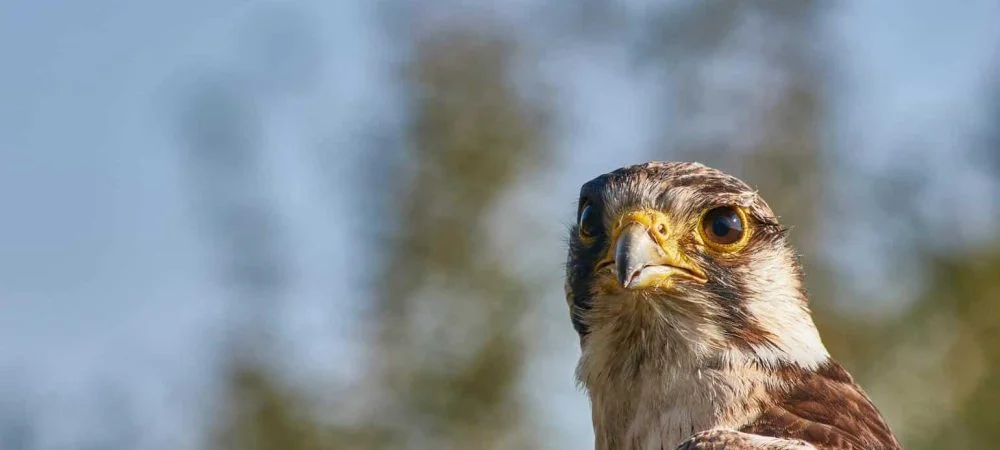
Want to learn more? This book on the Birds of Prey of North America is a fantastic read!
Delaware is a small Mid-Atlantic state in the United States.
Its unique geographic location is marked by dune-backed beaches that border the Atlantic Ocean, Delaware River, and Delaware Bay.
Delaware has a humid subtropical climate with warm to hot summers and mild to cold winters.
The climate is heavily impacted by the Atlantic Ocean, the Atlantic High, and the Appalachian Mountains. Delaware is home to 17 incredible state parks with an interesting 9 species of hawk that can be readily seen throughout the state.
Below you’ll find a convenient description for each hawk seen in Delaware, including the ideal time and place to find them.
Want to attract birds of prey to your yard? Take a look at our article!
What Hawks can be seen in Delaware?
Table of Contents
1. Sharp-Shinned Hawk
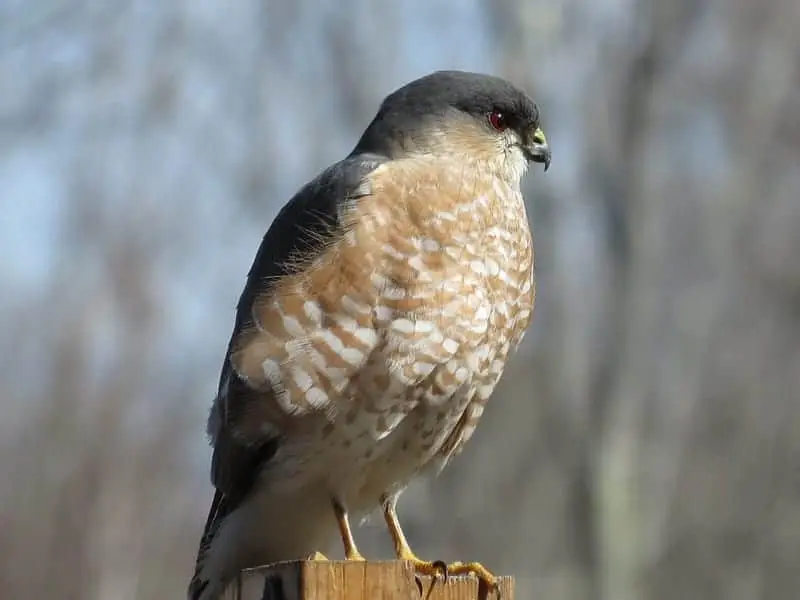
“Sharp-Shinned Hawk” by ‘Dennis Murhpy‘ is licensed under CC BY 2.0
Wingspan
43-56cm
Weight
87-218g
Life Expectancy
3 years
Diet
Robins and Thrushes
The Sharp-Shinned Hawk is a small species known for its short and rounded wings.
In fact, these hawks are so small that they are classified as the smallest in the United States. Though females are notably larger than their male partners.
Adult Sharp-Shinned Hawks are gray with pale orange underbellies. Juvenile hawks, however, are a streaky brown color.
Sharp-Shinned hawks like to breed and build their nests among forests in lush, thick trees.
They actually make their nests in hideaway places from twigs, bark, and other tree materials.
These hawks have two familiar calls: ‘kik-kik’ and a general high pitched squeal. Sharp-Shinned Hawks in Delaware are known to be athletic, flying through woods and backyards at high speeds.
They are most often seen during spring and summer months around bird feeders, waiting to prey on songbirds.
2. Cooper’s Hawk
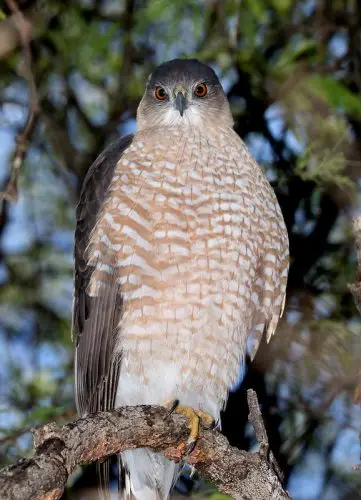
Wingspan
62-90cm
Weight
330-680g
Life Expectancy
Up to 12 years
Diet
Small Birds, Mice & Squirrels
Cooper’s Hawk are small to medium-sized and usually recognized for their petite wings and tails.
Adults hawks display their light blue feathers on their backs and wings with pale red feathers on their bellies.
Cooper’s Hawks like to nest in wooded places such as dense forests to small backyards. These hawks are praised for their flying agility and deep, “cak-cak-cak” sounding calls.
These hawks are very easily spotted in Delaware, however they tend to be a nuisance to residents.
Cooper’s hawks like to prey on songbirds that visit backyard feeders, and are often seen in suburban areas chasing their prey.
3. Northern Goshawk
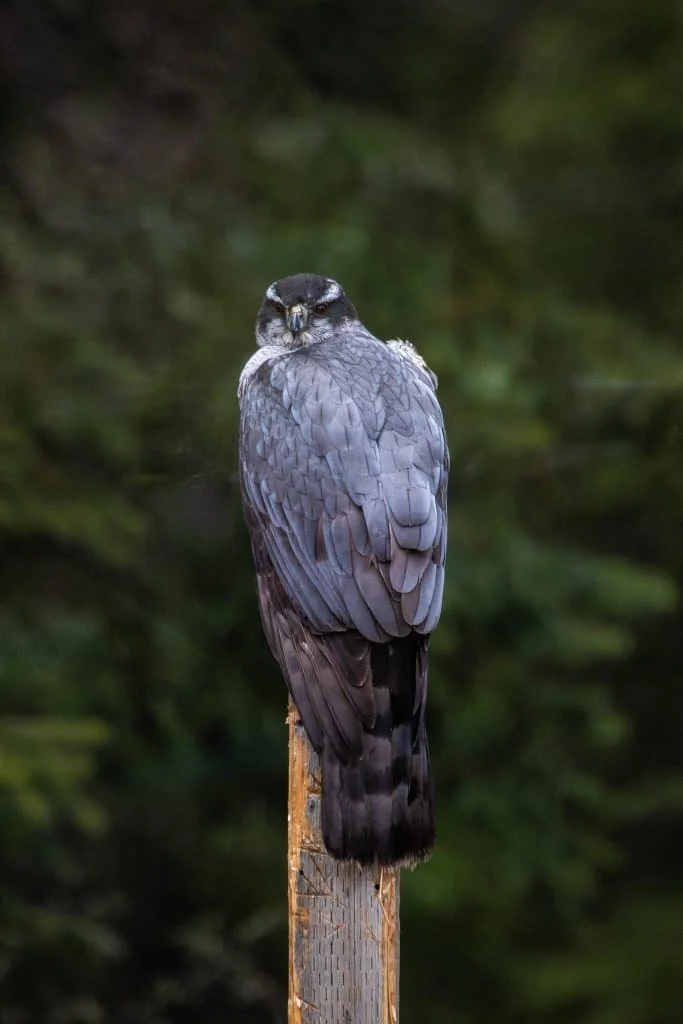
Wingspan
89-127cm
Weight
631-1364g
Life Expectancy
7 Years
Diet
Mammals, reptiles & insects
Northern Goshawks are medium to large in size and vary in color.
The adult hawks are gray on top with more pale gray colored feathers on their underparts. Immature hawks, on the other hand, have brown feathers.
This species’ females are larger and heavier than males. You’ll recognize Goshawks by their quick ‘ki-ki-ki’ call.
You can also find them nesting in forests among cone-bearing trees, but they are highly defensive when it comes to their homes!
Goshawks typically breed from April to June, and are sometimes seen during the spring and autumn.
Northern Goshawks are widespread in their range in Delaware and are sometimes difficult to spot.
Some of these hawks are short term migrants during the winter, but other hawks stay in the same area year-round.
Though there have been numerous sightings, some Goshawks are secretive birds and prefer living in large forests away from civilization.
4. Red-Shouldered Hawk
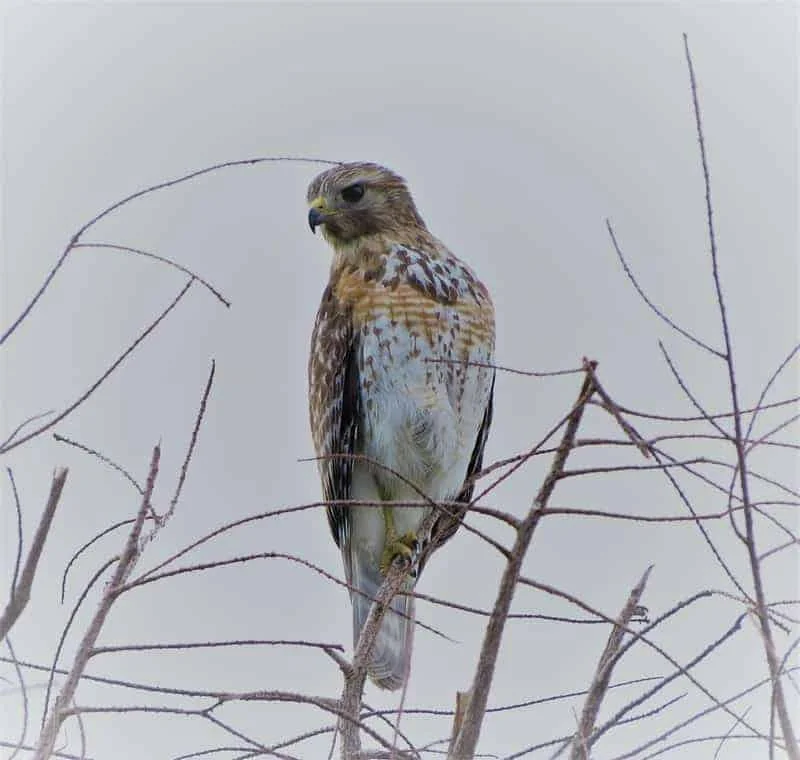
Wingspan
94-111cm
Weight
486g-774g
Life Expectancy
2 years
Diet
Small mammals, reptiles & amphibians
The Red-Shouldered Hawk is a large species known for its orange colored feathers, barred rufous chest, white underwings, and banded tail.
However, mature hawks can be very diverse in color patterns. The younger hawks tend to have white bellies and brown feathers on their backs.
These hawks build their nests in forests and coniferous trees by marshes and wetlands. They are known to make their nests in tree trunks.
This hawk’s call is very distinguishable from other calls; it is a ‘kee-aah’ sound that repeats itself in various high and low notes.
The best opportunity to observe a Red-Shouldered Hawk in Delaware is actually during the winter months, according to residents.
They are commonly seen in suburban areas where houses are mixed into woodlands hunting for food and backyard prey. Otherwise, they can be seen zipping through the sky at high heights!
5. Broad-Winged Hawk
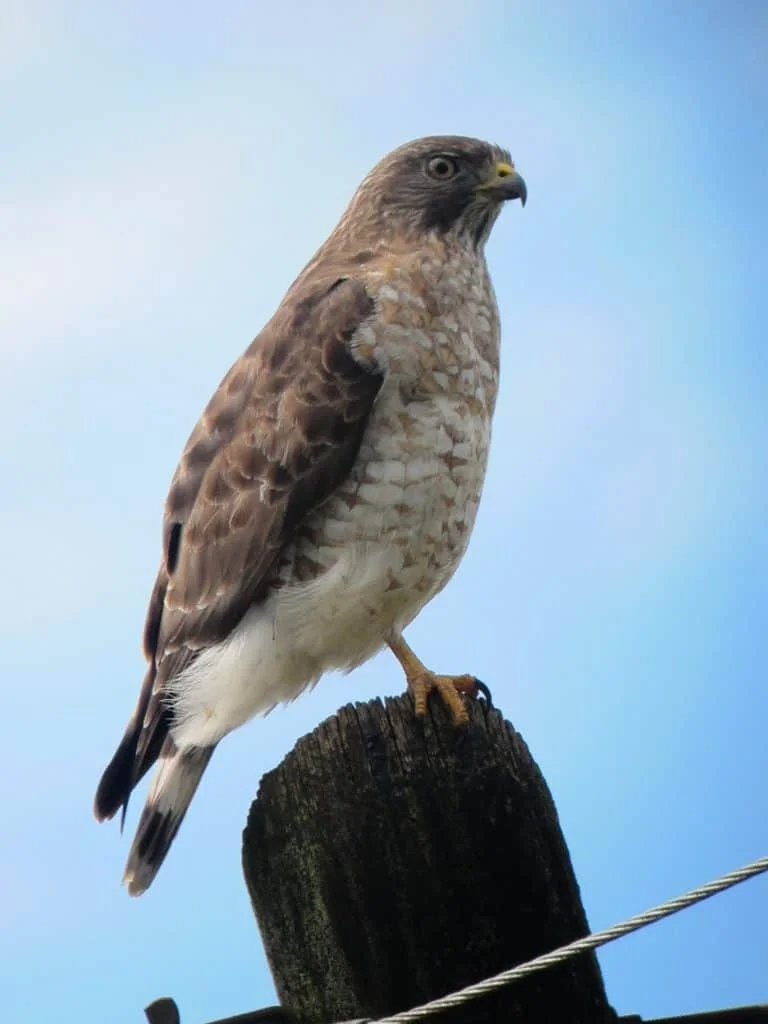
“Broad Winged Hawk” by ‘Felipe Uribe‘ is licensed under CC BY 2.0
Wingspan
81-100cm
Weight
265g-560g
Life Expectancy
Up to 20 years
Diet
Small mammals & insects
Broad-Winged Hawks are a medium sized bird and typically have russet-colored feathers with notable black and white bars that adorn their tails.
As with many hawks, juvenile Broad-Wings differ in color and have lighter brown feathers. Broad-Wings like to build their nests in forests, near water.
These hawks are recognizable from their loud, short and long note, high-pitched tones.
Female calls are even higher pitched than the male hawks. These hawks migrate in the fall so you’re most likely to see them in the summer and earlier fall months.
They are fairly common in Delaware but are not often seen because they prefer spending their time away from humans.
6. Swainson’s Hawk
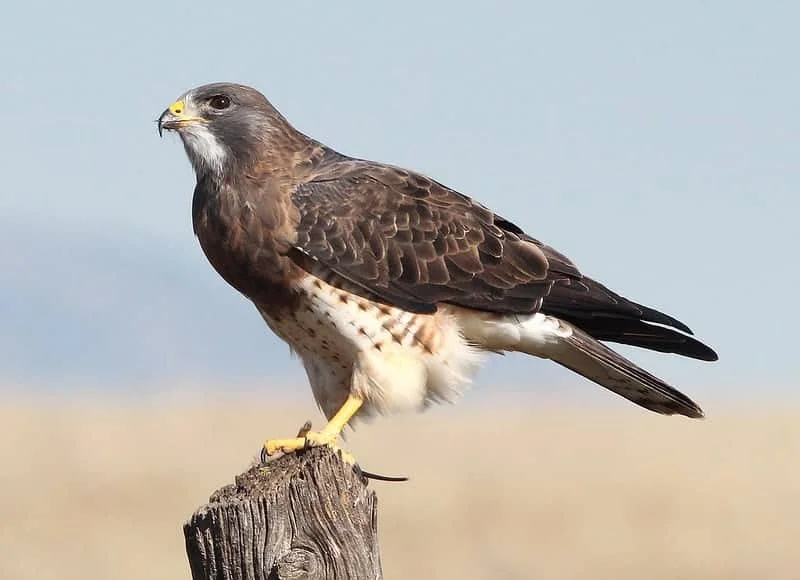
Wingspan
4 feet
Weight
693-1367g
Life Expectancy
16-19 years
Diet
Mammals & Insects
Swainson’s Hawks are large, have short tails, large wings, and are usually dark with the exception of their bright white underparts.
Swainson’s Hawks can be identified by their alarm call that is usually alerting others of a threat. Similar to other species, the females have shorter and deeper calls than the males.
For the most part, Swainson’s Hawks migrate in late August. While they are seen in open areas such as fields, they live in grassy areas where they build their nests in high resting places.
They are usually spotted perched on high places to gain a view of open grasslands.
They use this open space to hunt for their prey. Though not as readily common as the other hawks, you can see a Swainson’s Hawk during summer months.
7. Red-Tailed Hawk
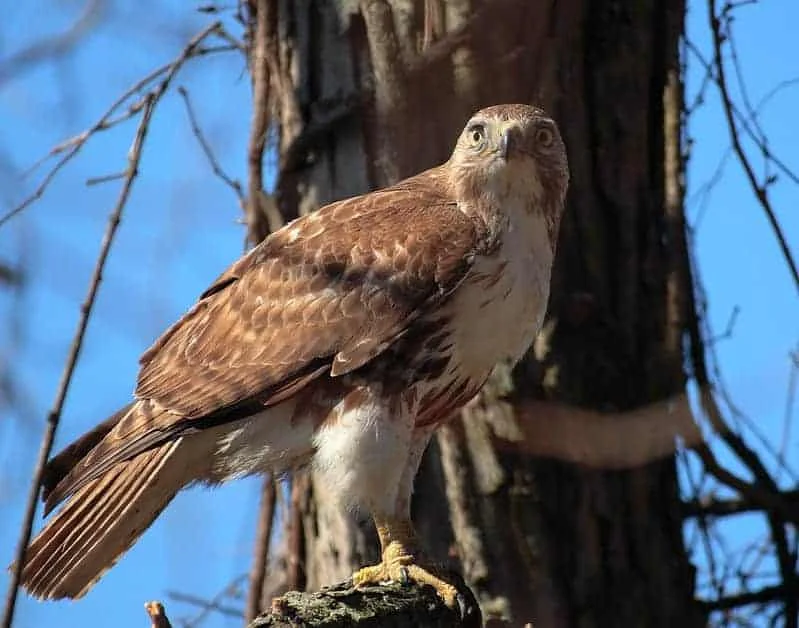
Wingspan
114-133cm
Weight
900-1460g
Life Expectancy
10-15 years
Diet
Small mammals, mice & voles
The Red-Tailed Hawk is the second largest hawk in North America and is known as the most common roadside raptor across North America.
This hawk has a variation in feather colors. Adult hawks have bold red-orange tails and pale underparts with dark marks on their bellies. Juvenile Red-Tailed Hawks do not have red tails.
Some hawks can be darker in different regions of the state.
They can be easily spotted upon telephone poles, light posts, or even tree edges.
They prefer to make their home in the open country, usually perching on single trees.
However, these hawks make their homes in diverse places in Delaware. It’s interesting to note that these hawk calls are often compared to the raptor screams in films.
They migrate in late fall and early spring. They also have fascinating breeding behaviors in which males circle at high heights in order to attract a female partner.
Red-Tailed hawks can easily be spotted throughout the state of Delaware and are highly adaptable.
They’ve been commonly spotted in Yellowstone National Park, urban cities, and suburban backyards!
8. Rough-Legged Hawk
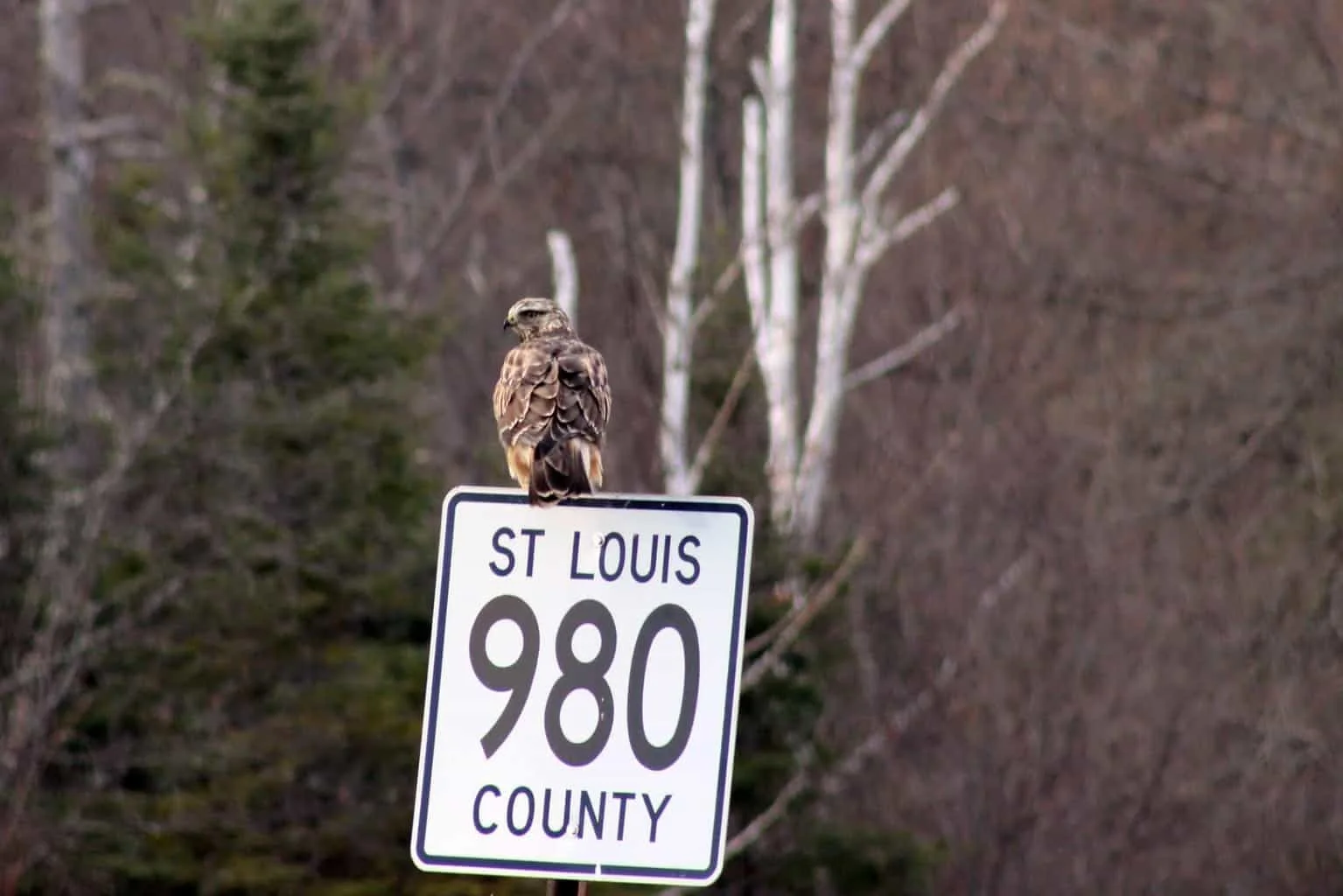
Wingspan
132-138cm
Weight
715-1400g
Life Expectancy
Up to 18 years
Diet
Small rodents
Rough-Legged Hawks are recognized as a medium-large bird species, highly renowned for their striking feather patterns.
They also have light colored heads, but dark underparts–their tails however are a variety of dark and light feathers.
Rough-Legged Hawks often hover in place, making them easier to spot! They tend to live in open areas due to this unique hunting style.
Rough-Legged Hawks build their nests with large twigs in open spaces such as on the sides of cliffs.
These hawks give an interesting catlike sound, it is very similar to a crying sound.
They are also known for their hiss sounding whistles. It’s common for Rough-Legged hawks to put on a display of circling in the air and diving to low depths.
However, you can only see these large hawks in Delaware during winter when they migrate south.
9. Northern Harrier
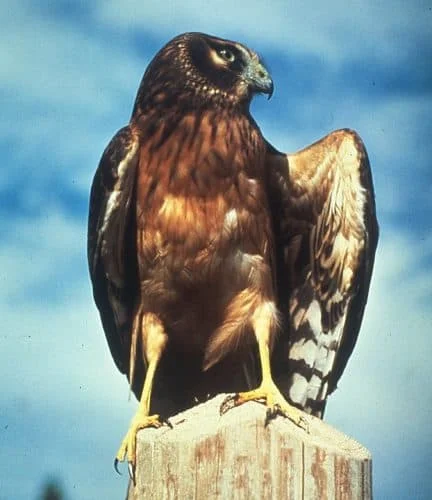
Wingspan
120cm
Weight
390g
Life Expectancy
16 years
Diet
Rodents and small birds
Northern Harriers are medium hawks that have long tails and relatively thin wings.
Adult male hawks have an overall gray color and white on their underparts. They also have black markings on their wingtips.
Female and juvenile hawks are brown. Northern Harriers like to nest over open fields and marshes, this is convenient for them to watch out for their prey.
You’ll recognize these hawks by their calls that resemble a quick round of ‘kek-kek-kek’ when males are approached by certain predators.
Female Northern Harriers, however, often offer a high pitched whistle. These hawks have been spotted near Delaware Bay shore in saline marshes during the autumn months

More Articles.
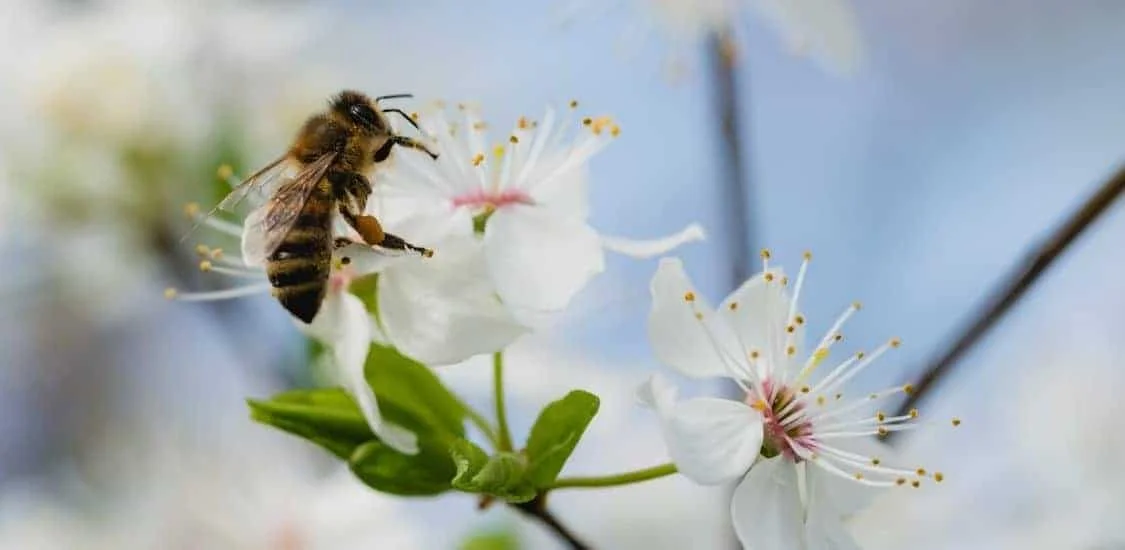
How to Attract Bees to Your Yard?
Bees play a vital role in the environment, helping to spread the pollen of flowers
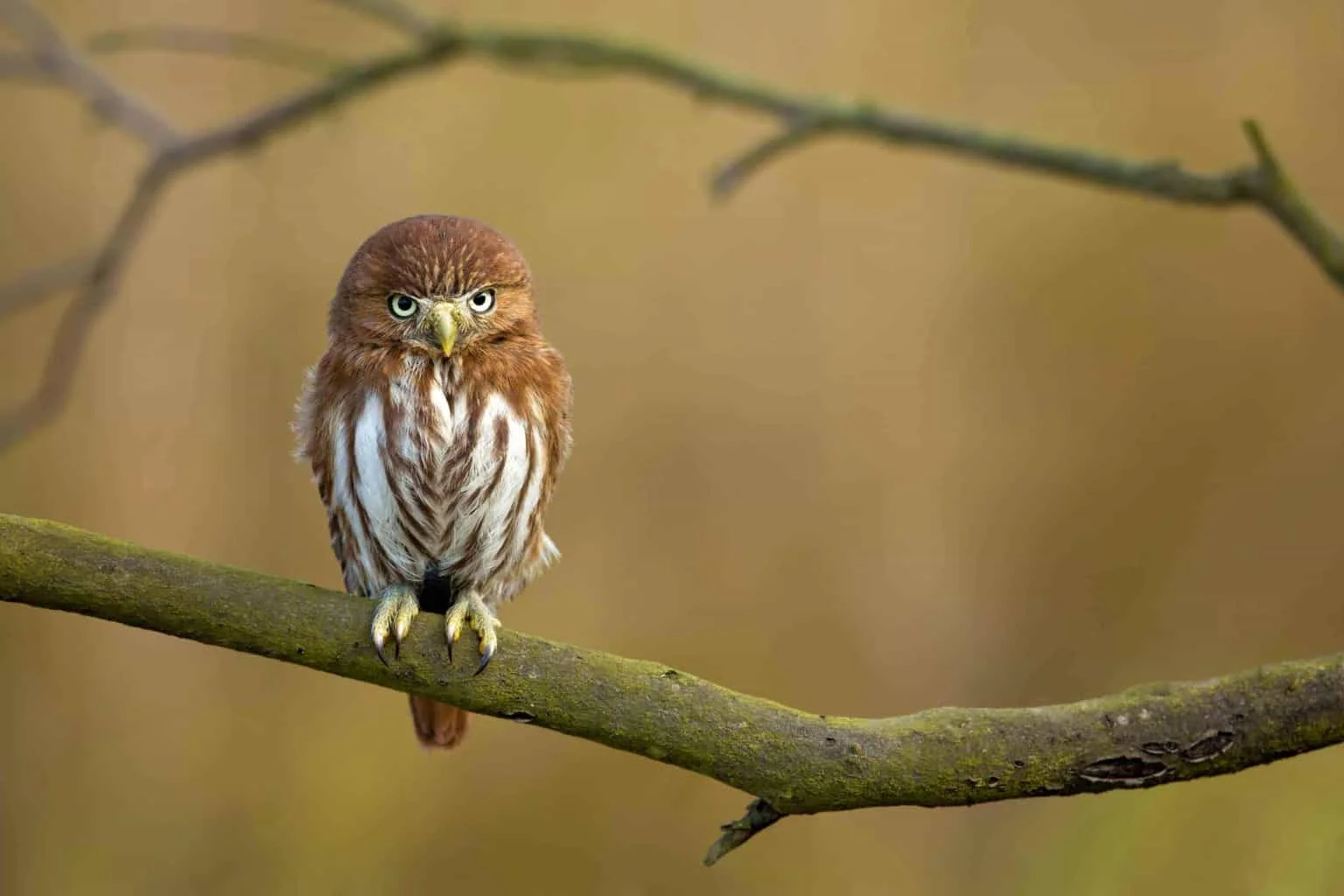
Owls are without a doubt one of the more interesting creatures around. These fearsome predators

Cardinals are one of the most beautiful birds around and are known to delight birdwatchers

About Us
We are avid bird-watchers who recently retired, allowing us more time to travel the world. Fortunately, we have managed to visit numerous countries around Europe, Asia, and America. Watching and photographing birds has been a passion for many years and we are making the most of the extra time on our hands!
